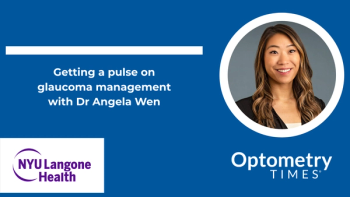
- September digital edition 2021
- Volume 13
- Issue 9
Angle closure presentation differs
Cases illustrate how acute and chronic angle-closure glaucoma are treated
ODs know from the Zhongshan Angle Closure Prevention (ZAP) trial that angle-closure glaucoma in the setting of narrow angles is low. However, when it does occur, the visual consequences can be dire. Acute and chronic angle-closure glaucoma present in different ways, and treatment for both conditions often involves surgical intervention, as the following 2 cases demonstrate.
Case 1
A 58-year-old woman presented to the SUNY glaucoma clinic. She was recently seen at the hospital because of a single episode of severe eye pain in her left eye for which she had to undergo emergency surgery. She is currently on dorzolamide hydrochloride-timolol maleate (Cosopt; Akorn), brimonidine tartrate (Alphagan P; Allergan), and latanprost.
Her incoming visual acuities were 20/25 in the right eye and 20/30 in the left eye. Upon slit lamp examination, the left eye exhibited extensive anterior synechiae covering about 180˚ of the temporal cornea (Figure 1A). A failed laser peripheral iridotomy (LPI) at 1 o’clock was noted; however, she had a patent surgical iridectomy at 11 o’clock. Anterior segment optical coherence tomography (OCT) confirmed the presence of synechiae in the left eye, and narrow angles in both eyes (Figures 1B and 1C). Intraocular pressures (IOPs) were 17 OD and 12 OS.
Noted in both eyes were 1+ nuclear and posterior subcapsular cataracts (PSCs) with glaukomflecken seen on anterior capsule OS. A 24-2 Humphrey visual field revealed scattered mild, nonspecific depressions OD with severe, dense 360˚ constriction OS (Figures 2A and 2B). A macular cube OCT and retinal nerve fiber layer (RNFL) showed significant 360˚ thinning of the ganglion cell complex (GCC) and RNFL in the left eye (Figures 3A and 3B). Axial length and anterior chamber depth measurements were taken using Zeiss IOLMaster, but measurements were only obtainable OD because of corneal clouding and PSC OS. Biometry shows a short axial length and a shallow anterior chamber depth of 2.19 mm (Figure 4).
Case 2
A 73-year-old woman presented to the SUNY primary care clinic with longstanding distance and near vision blur, frontal headaches, and irritation and discomfort of both eyes. She reported that her vision has been progressively worsening over the past few years, and she was told by her optometrist to get a cataract evaluation 2 years ago. She reported experiencing irritation and redness in both eyes, but more so OD than OS. She used Visine for the redness. Her pertinent medical history included hypertension and hypercholesterolemia, both of which were being medically managed. She reported no family history of glaucoma.
Her incoming visual acuities were 20/25-1 OD and 20/25 OS. She exhibited an afferent pupillary defect with a sluggish response and 360˚ constricted field OD based on confrontation visual field. The pupil response and confrontation visual field were normal OS. Slit lamp exam showed narrow angles with the Van Herick technique, and gonioscopy revealed no structures 360˚ in either eye with a convex iris approach in both eyes. IOP measured 34 mm Hg OD and 14 mm Hg OS with Goldmann applanation tonometry. A 30-2 Humphrey visual field revealed dense loss with a severely constricted visual field OD and scattered nasal depressions OS (Figures 6A and 6B). Further glaucoma testing revealed thinning on the RNFL greater OD than OS with corresponding GCC loss (Figures 7 and 8).
Anterior segment OCT confirmed significantly narrow angles in both eyes, with areas of closure in the right eye (Figures 5A and 5B). Pachymetry was measured to be 494 mm in the right eye and 501 mm in the left eye.
The first case represents a classic case of acute angle-closure glaucoma, whereas the second demonstrates chronic angle-closure glaucoma.
PATHOGENESIS AND PRESENTATION
Acute angle-closure glaucoma
Acute angle-closure glaucoma most commonly occurs when pupil dilation results in iridolenticular contact and subsequent pupillary block. Pupillary block then causes pressure to build in the posterior chamber, pushing the peripheral iris into apposition with the anterior chamber angle. When the angle is acutely occluded, IOP rises quickly and typically reaches levels of above 30 mm Hg. Visual field loss from damage to the optic nerve can be extensive and may occur in a matter of hours or days if the pressure remains significantly elevated.2-4
An acute angle closure attack is an emergency, and patients are typically severely symptomatic. Symptoms include ocular pain, nausea or vomiting, blurred vision, and halos around lights. The presenting signs include extensive conjunctival hyperemia, a mid-dilated minimally reactive pupil, corneal edema, and high IOP.2-4
Chronic angle-closure glaucoma
Chronic angle-closure glaucoma follows a similar pathogenesis as acute angle closure but with a few distinct differences. It can occur after an acute angle closure attack that produces anterior or posterior synechiae or through transient angle closure in which the IOP periodically rises and results in cumulative damage and occlusion of the trabecular meshwork.2-4
The process of transient angle closure is the most common form, and patients are often asymptomatic. The mild, nonspecific symptoms lead to a delay in diagnosis, and the resulting vision loss can be devastating. When patients do experience symptoms, they tend to occur in dim lighting conditions and include frontal headaches, intermittent blurred vision, red eyes, and variable ocular pain.2-4
Treatments
The current standards of care for acute and chronic angle-closure glaucoma include lowering the IOP with topical or oral drugs and subsequently performing LPI in both eyes. LPI equalizes the pressure between the anterior and posterior chambers, thereby reducing the risk of pupillary block.2-4
The ZAP trial explored the benefit of prophylactic LPI in patients suspected of primary angle closure. Study results showed that although overall incidence of angle closure is low, prophylactic LPI showed statistically significant reduction of the risk of glaucomatous damage from angle closure. However, the justification of prophylactic treatment on a widespread population basis is low; hence investigators recommend that at-risk patients be monitored closely, and treatment be initiated only when suspicion of glaucomatous progression is high.1
Alternative treatments have recently been explored with positive results from early lens extraction as shown in the EAGLE trial. Extraction of the natural lens results in a deepened anterior chamber and eliminates the risk of pupillary block. Researchers’ results suggest that clear lens extraction should be considered as first-line treatment over LPI in cases of primary angle-closure glaucoma.5
Conclusion
Acute angle-closure glaucoma and chronic angle-closure glaucoma are 2 processes with distinctly different presenting signs but similar manifestations regarding the resulting visual field loss if not promptly treated. Both conditions arise from similar structural etiologies, including anatomically narrow angles, plateau iris, shallow anterior chamber, anteriorly positioned lens, cataracts, and thick irides.1,2,4,5 Risk factors for angle closure include Asian ethnicity, family history, hyperopia, female sex, and older age.2,4 The current standard of care for acute and chronic angle-closure glaucoma involves lowering the IOP with topical or oral drugs and subsequently performing LPI or lens extraction.1,3-5
Although acute angle-closure glaucoma and chronic angle-closure glaucoma present in different ways, these cases demonstrate that the resulting glaucomatous defects can be similar and severe. It is crucial that these patients be identified and receive prompt care to prevent irreversible damage.
References
1. He M, Jiang Y, Huang S, et al. Laser peripheral iridotomy for the prevention of angle closure: a single-centre, randomised controlled trial. Lancet. 2019;393(10181):1609-1618. doi:10.1016/S0140-6736(18)32607-2
2. Khondkaryan A, Francis BA. Angle-closure glaucoma. American Academy of Ophthalmology. December 18, 2013. Accessed August 24, 2021. https://www.aao.org/munnerlyn-laser-surgery-center/ angleclosure-glaucoma-19
3. Weinreb RN, Aung T, Medeiros FA. The pathophysiology and treatment of glaucoma: a review. JAMA. 2014;311(18):1901-1911. doi:10.1001/jama.2014.3192
4. Wormald RPL, Jones E. Glaucoma: acute and chronic primary angle-closure. BMJ Clin Evid. 2015;2015:0703.
5. Azuara-Blanco A, Burr J, Ramsay C, et al. Effectiveness of early lens extraction for the treatment of primary angle-closure glaucoma (EAGLE): a randomised controlled trial. Lancet. 2016;388(10052):1389- 1397. doi:10.1016/S0140-6736(16)30956-4
Articles in this issue
over 4 years ago
CASE REPORT: Self-induced maculopathy by 12-year-old boyover 4 years ago
ODs are ignoring macular degenerationover 4 years ago
Pupil size matters in presbyopia treatmentover 4 years ago
Aesthetics and eye care are a natural fitNewsletter
Want more insights like this? Subscribe to Optometry Times and get clinical pearls and practice tips delivered straight to your inbox.








































